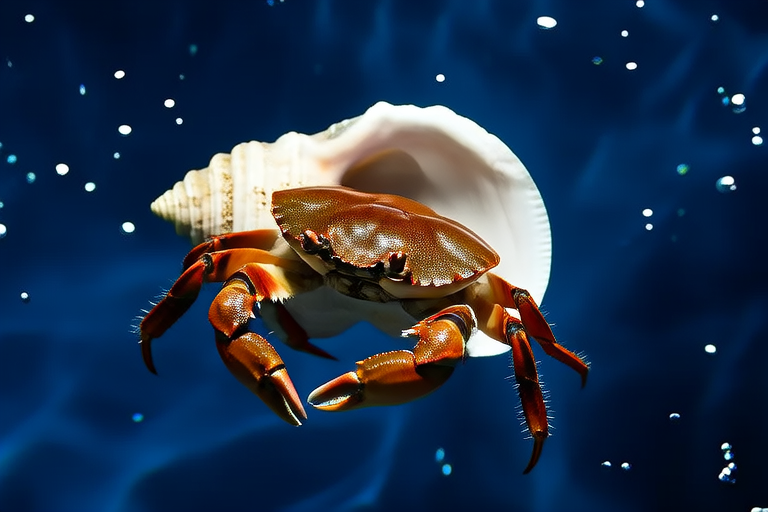The Enigmatic Pea Crabs: Tiny Architects of Marine Symbiosis
Pea crabs (Pinnotheridae) are a family of small, often overlooked crustaceans that have evolved an extraordinary symbiotic relationship with various marine organisms, particularly sea cucumbers and anemones. These diminutive creatures, named for their resemblance to peas, are fascinating examples of nature’s ingenuity in survival and adaptation. Their unique lifestyle has intrigued marine biologists for decades, and recent studies continue to unravel the mysteries surrounding their behavior, life cycle, and ecological significance.
A Tiny World Within
Pea crabs are among the smallest true crabs, measuring just a few millimeters in length. Despite their petite size, these creatures possess all the necessary adaptations to thrive within their chosen hosts. Their carapaces, or shells, are typically soft and pliable, allowing them to squeeze through narrow openings and fit snugly inside their hosts. The flexibility of their shells is crucial for their survival, as it enables them to avoid detection by predators and maintain a secure position within their host.
Pea crabs exhibit remarkable adaptability, adjusting their size and shape to match that of their host. This morphological plasticity ensures that they can coexist harmoniously with their hosts without causing undue stress or harm. Their ability to blend in with their environment provides them with protection from larger predators and allows them to exploit the resources available within their host’s body.
Symbiotic Partnerships
Pea crabs form symbiotic relationships with a variety of marine animals, including sea cucumbers and anemones. In these partnerships, both parties benefit from each other’s presence. Sea cucumbers, for instance, provide shelter and protection for the pea crabs, while the crabs help clean the sea cucumbers’ bodies by feeding on parasites, detritus, and other unwanted material. This mutualistic relationship promotes the health and well-being of both species, contributing to the overall stability of marine ecosystems.
Anemones also serve as hosts for pea crabs, offering them a safe haven and access to food. The crabs take advantage of the anemone’s tentacles to catch small prey, while the anemone benefits from the crabs’ cleaning activities. This interaction highlights the intricate web of relationships that exists within marine environments, where even the tiniest organisms play a vital role in maintaining balance and biodiversity.
Lifecycle and Mating Habits
The lifecycle of pea crabs is characterized by several distinct stages, each marked by significant changes in morphology and behavior. Female pea crabs typically enter their host during the larval stage, seeking out a suitable environment in which to mature and reproduce. Once inside the host, they undergo metamorphosis, developing into adults and establishing themselves within the host’s body cavity.
Mating occurs within the host, with males and females pairing up to produce offspring. After mating, the female carries her eggs within her body until they hatch. The larvae then disperse into the surrounding water, where they search for new hosts to begin their own lifecycle. This reproductive strategy ensures the continuation of the species and helps maintain the delicate balance between host and symbiont.
Recent Discoveries and Insights
Recent studies have provided valuable insights into the behavior and ecology of pea crabs, shedding light on their role within marine ecosystems. Researchers have discovered that pea crabs play a crucial role in nutrient cycling within their hosts, contributing to the overall health and productivity of marine environments. By feeding on organic matter and waste products, pea crabs help break down complex compounds, making them more readily available to other organisms.
In addition, scientists have found that pea crabs may influence the behavior of their hosts, potentially altering their movement patterns and feeding habits. This finding suggests that the presence of pea crabs could have far-reaching implications for the structure and function of marine ecosystems, influencing everything from predator-prey dynamics to nutrient distribution.
The Future of Pea Crab Research
As our understanding of pea crabs continues to grow, researchers are exploring new avenues for studying these fascinating creatures. Advances in molecular biology and genetics offer exciting opportunities to investigate the genetic basis of their symbiotic relationships and adaptability. Additionally, ongoing efforts to protect and conserve marine ecosystems will likely lead to increased attention on the role of pea crabs and other small, symbiotic organisms in maintaining ecosystem health.
By delving deeper into the world of pea crabs, we can gain valuable insights into the intricate workings of marine ecosystems and the myriad ways in which organisms interact and depend on one another. As we continue to uncover the secrets of these tiny architects of symbiosis, we may find new ways to protect and preserve the delicate balance of life beneath the waves.
Conclusion
Pea crabs are remarkable examples of nature’s ingenuity, showcasing the power of symbiosis in promoting survival and adaptation. Through their unique relationship with sea cucumbers, anemones, and other marine organisms, these tiny creatures have carved out a niche for themselves within the vast and diverse world of marine life. As we continue to explore the mysteries of the ocean, pea crabs remind us of the importance of every organism, no matter how small, in maintaining the delicate balance of life in our oceans.
